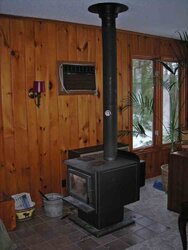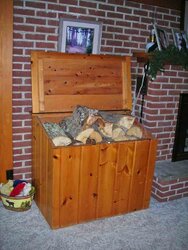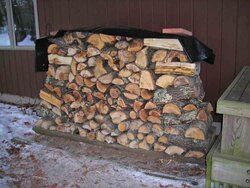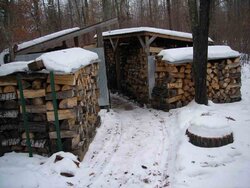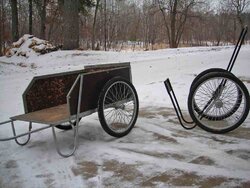Thought I’d tell our wood heat story.
We heat just over 1500 sq ft, single level, very open floor plan house, 51 years old, 3-1/2" wall insulation, 18" ceiling insulation, very good windows. The house faces the SW and is mostly open to the NW, the main direction of our winter winds. We have 30' of glass across the front, and on sunny winter days we gain considerable passive solar through the high efficiency windows. In fact, on most winter, sunny days we don’t need to use the stove at all due to solar heating. Unfortunately, late Oct to early Jan typically is mostly cloudy. Later Jan into Mar is usually quite sunny.
We installed the wood stove and chimney in Oct 1990. It is our only source of heat, except when we’re away for brief periods. Then electric baseboard backup. Our winters are long and cold. The heating season starts with late Sept and ends in May. Really cold periods typically run -25 at night and -5 daytime (-55 is the coldest we have had at night and -30 in the daytime); most of middle winter runs 5-20.
The stove is a SeeFire 1600S, EPA certified, 7.1 gr/hr emissions, 55,000 btu/hr rated. It is entirely lined with firebrick, except for the secondary burn baffle. The stove keeps 2/3 of the house 68-72 typical regardless of outside temperature or wind conditions. The parts of the house furthest from the stove may drop to 50-55 during the really cold periods.
The wood box is 2'W x 3'4"L x 2'8"H. During really cold periods it holds 3 days of wood, during typical winter periods, 4-5 days of wood.
We cut, split and stack our wood supply in two woodsheds, 8' x 18' x 6' and 8' x 20' x 6', for about 14 cords of storage. We typically have an additional 3 cords stacked and covered in the open. The wood is usually cut from diseased and storm damaged trees from our own land. Typical heating season runs 4-6 cords. Our firewood is almost all aspen, as we have lots of that available to us. We always burn wood dried for 3 summers.
The wood sheds are about 50 yards from the house. I use a two wheel cart to move wood to a small stack by the house. The stack holds 3 cart loads. I then use a small 2 wheel cart to move loads of wood into the house to fill the wood box.
After nearly 18 heating seasons, I conservatively estimate we have saved $20,000 - $30,000 in heating costs. Total stove/chimney investment was about $2,000 in 1990.
We heat just over 1500 sq ft, single level, very open floor plan house, 51 years old, 3-1/2" wall insulation, 18" ceiling insulation, very good windows. The house faces the SW and is mostly open to the NW, the main direction of our winter winds. We have 30' of glass across the front, and on sunny winter days we gain considerable passive solar through the high efficiency windows. In fact, on most winter, sunny days we don’t need to use the stove at all due to solar heating. Unfortunately, late Oct to early Jan typically is mostly cloudy. Later Jan into Mar is usually quite sunny.
We installed the wood stove and chimney in Oct 1990. It is our only source of heat, except when we’re away for brief periods. Then electric baseboard backup. Our winters are long and cold. The heating season starts with late Sept and ends in May. Really cold periods typically run -25 at night and -5 daytime (-55 is the coldest we have had at night and -30 in the daytime); most of middle winter runs 5-20.
The stove is a SeeFire 1600S, EPA certified, 7.1 gr/hr emissions, 55,000 btu/hr rated. It is entirely lined with firebrick, except for the secondary burn baffle. The stove keeps 2/3 of the house 68-72 typical regardless of outside temperature or wind conditions. The parts of the house furthest from the stove may drop to 50-55 during the really cold periods.
The wood box is 2'W x 3'4"L x 2'8"H. During really cold periods it holds 3 days of wood, during typical winter periods, 4-5 days of wood.
We cut, split and stack our wood supply in two woodsheds, 8' x 18' x 6' and 8' x 20' x 6', for about 14 cords of storage. We typically have an additional 3 cords stacked and covered in the open. The wood is usually cut from diseased and storm damaged trees from our own land. Typical heating season runs 4-6 cords. Our firewood is almost all aspen, as we have lots of that available to us. We always burn wood dried for 3 summers.
The wood sheds are about 50 yards from the house. I use a two wheel cart to move wood to a small stack by the house. The stack holds 3 cart loads. I then use a small 2 wheel cart to move loads of wood into the house to fill the wood box.
After nearly 18 heating seasons, I conservatively estimate we have saved $20,000 - $30,000 in heating costs. Total stove/chimney investment was about $2,000 in 1990.


